"A-bomb" redirects here. For other uses, see A-bomb (disambiguation).
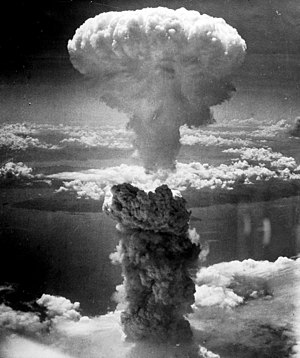
The mushroom cloud of the atomic bombing of Nagasaki, Japan on August 9, 1945 rose some 18 kilometers (11 miles) above the bomb's hypocenter.
| Nuclear weapons |
|---|
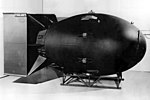 |
| History Warfare Arms race Design Testing Effects Delivery Espionage Proliferation Arsenals Terrorism Civil defense Anti-nuclear opposition |
| Nuclear-armed states |
| United States · Russia United Kingdom · France China · India · Israel Pakistan · North Korea South Africa (former) |
A modern thermonuclear weapon weighing little more than a thousand kilograms (2,200 pounds) can produce an explosion comparable to the detonation of more than a billion kilograms (2.2 billion pounds) of conventional high explosive.[2] Thus, even single small nuclear devices no larger than traditional bombs can devastate an entire city by blast, fire and radiation. Nuclear weapons are considered weapons of mass destruction, and their use and control has been a major focus of international relations policy since their debut.
In the history of warfare, only two nuclear weapons have been detonated offensively, both near the end of World War II. The first was detonated on the morning of 6 August 1945, when the United States dropped a uranium gun-type device code-named "Little Boy" on the Japanese city of Hiroshima. The second was detonated three days later when the United States dropped a plutonium implosion-type device code-named "Fat Man" on the city of Nagasaki, Japan. These two bombings resulted in the deaths of approximately 200,000 Japanese people (mostly civilians) from acute injuries sustained from the explosion.[3] The role of the bombings in Japan's surrender, and the U.S.'s ethical justification for them, remain the subject of scholarly and popular debate.
Since the Hiroshima and Nagasaki bombings, nuclear weapons have been detonated on over two thousand occasions for testing purposes and demonstration purposes. A few states have possessed such weapons or are suspected of seeking them. The only countries known to have detonated nuclear weapons—and that acknowledge possessing such weapons—are (chronologically) the United States, the Soviet Union (succeeded as a nuclear power by Russia), the United Kingdom, France, the People's Republic of China, India, Pakistan, and North Korea. Israel is also widely believed to possess nuclear weapons, though it does not acknowledge having them.[4][5]
Contents[hide] |
Types of nuclear weapons

The two basic fission weapon designs
Main article: Nuclear weapon design
There are two basic types of nuclear weapon. The first type produces its explosive energy through nuclear fission reactions alone. Such fission weapons are commonly referred to as atomic bombs or atom bombs (abbreviated as A-bombs), though their energy comes specifically from the nucleus of the atom.In fission weapons, a mass of fissile material (enriched uranium or plutonium) is assembled into a supercritical mass—the amount of material needed to start an exponentially growing nuclear chain reaction—either by shooting one piece of sub-critical material into another (the "gun" method) or by compressing a sub-critical sphere of material using chemical explosives to many times its original density (the "implosion" method). The latter approach is considered more sophisticated than the former and only the latter approach can be used if the fissile material is plutonium.
A major challenge in all nuclear weapon designs is to ensure that a significant fraction of the fuel is consumed before the weapon destroys itself. The amount of energy released by fission bombs can range from the equivalent of less than a ton of TNT upwards of 500,000 tons (500 kilotons) of TNT.[6]
The second basic type of nuclear weapon produces a large amount of its energy through nuclear fusion reactions. Such fusion weapons are generally referred to as thermonuclear weapons or more colloquially as hydrogen bombs (abbreviated as H-bombs), as they rely on fusion reactions between isotopes of hydrogen (deuterium and tritium). However, all such weapons derive a significant portion, and sometimes a majority, of their energy from fission (including fission induced by neutrons from fusion reactions). Unlike fission weapons, there are no inherent limits on the energy released by thermonuclear weapons. Only six countries—United States, Russia, United Kingdom, People's Republic of China, France and India—have conducted thermonuclear weapon tests. (Whether India has detonated a "true", multi-staged thermonuclear weapon is controversial.)[7]

The basics of the Teller–Ulam design for a hydrogen bomb: a fission bomb uses radiation to compress and heat a separate section of fusion fuel.
By chaining together numerous stages with increasing amounts of fusion fuel, thermonuclear weapons can be made to an almost arbitrary yield; the largest ever detonated (the Tsar Bomba of the USSR) released an energy equivalent of over 50 million tons (50 megatons) of TNT. Most thermonuclear weapons are considerably smaller than this, due to practical constraints arising from the space and weight requirements of missile warheads.[8]
There are other types of nuclear weapons as well. For example, a boosted fission weapon is a fission bomb which increases its explosive yield through a small amount of fusion reactions, but it is not a fusion bomb. In the boosted bomb, the neutrons produced by the fusion reactions serve primarily to increase the efficiency of the fission bomb. Some weapons are designed for special purposes; a neutron bomb is a thermonuclear weapon that yields a relatively small explosion but a relatively large amount of neutron radiation; such a device could theoretically be used to cause massive casualties while leaving infrastructure mostly intact and creating a minimal amount of fallout.
The detonation of any nuclear weapon is accompanied by a blast of neutron radiation. Surrounding a nuclear weapon with suitable materials (such as cobalt or gold) creates a weapon known as a salted bomb. This device can produce exceptionally large quantities of radioactive contamination.
Most variation in nuclear weapon design is for the purpose of achieving different yields for different situations, and in manipulating design elements to attempt to minimize weapon size.[6]
Weapons delivery

The first nuclear weapons were gravity bombs, such as this "Fat Man" weapon dropped on Nagasaki, Japan. They were very large and could only be delivered by heavy bomber aircraft
Main article: Nuclear weapons delivery
Nuclear weapons delivery—the technology and systems used to bring a nuclear weapon to its target—is an important aspect of nuclear weapons relating both to nuclear weapon design and nuclear strategy. Additionally, development and maintenance of delivery options is among the most resource-intensive aspects of a nuclear weapons program: according to one estimate, deployment costs accounted for 57% of the total financial resources spent by the United States in relation to nuclear weapons since 1940.[9]Historically the first method of delivery, and the method used in the two nuclear weapons actually used in warfare, was as a gravity bomb, dropped from bomber aircraft. This method is usually the first developed by countries as it does not place many restrictions on the size of the weapon and weapon miniaturization is something which requires considerable weapons design knowledge. It does, however, limit the range of attack, the response time to an impending attack, and the number of weapons which can be fielded at any given time.
With the advent of miniaturization, nuclear bombs can be delivered by both strategic bombers and tactical fighter-bombers, allowing an air force to use its current fleet with little or no modification. This method may still be considered the primary means of nuclear weapons delivery; the majority of U.S. nuclear warheads, for example, are free-fall gravity bombs, namely the B61.[6]
More preferable from a strategic point of view is a nuclear weapon mounted onto a missile, which can use a ballistic trajectory to deliver the warhead over the horizon. While even short range missiles allow for a faster and less vulnerable attack, the development of long-range intercontinental ballistic missiles (ICBMs) and submarine-launched ballistic missiles (SLBMs) has given some nations the ability to plausibly deliver missiles anywhere on the globe with a high likelihood of success.
More advanced systems, such as multiple independently targetable reentry vehicles (MIRVs), allow multiple warheads to be launched at different targets from one missile, reducing the chance of a successful missile defense. Today, missiles are most common among systems designed for delivery of nuclear weapons. Making a warhead small enough to fit onto a missile, though, can be a difficult task.[6]
Tactical weapons have involved the most variety of delivery types, including not only gravity bombs and missiles but also artillery shells, land mines, and nuclear depth charges and torpedoes for anti-submarine warfare. An atomic mortar was also tested at one time by the United States. Small, two-man portable tactical weapons (somewhat misleadingly referred to as suitcase bombs), such as the Special Atomic Demolition Munition, have been developed, although the difficulty of combining sufficient yield with portability limits their military utility.[6]
Nuclear strategy

The United States' Peacekeeper missile was a MIRVed delivery system. Each missile could contain up to ten nuclear warheads (shown in red), each of which could be aimed at a different target. These were developed to make missile defense very difficult for an enemy country.
Main article: Nuclear warfare
Nuclear warfare strategy is a set of policies that deal with preventing or fighting a nuclear war. The policy of trying to prevent an attack by a nuclear weapon from another country by threatening nuclear retaliation is known as the strategy of nuclear deterrence. The goal in deterrence is to always maintain a second strike capability (the ability of a country to respond to a nuclear attack with one of its own) and potentially to strive for first strike status (the ability to completely destroy an enemy's nuclear forces before they could retaliate). During the Cold War, policy and military theorists in nuclear-enabled countries worked out models of what sorts of policies could prevent one from ever being attacked by a nuclear weapon.Different forms of nuclear weapons delivery (see above) allow for different types of nuclear strategies. The goals of any strategy are generally to make it difficult for an enemy to launch a pre-emptive strike against the weapon system and difficult to defend against the delivery of the weapon during a potential conflict. Sometimes this has meant keeping the weapon locations hidden, such as deploying them on submarines or rail cars whose locations are very hard for an enemy to track and other times this means protecting them by burying them in hardened bunkers.
Other components of nuclear strategies have included using missile defense (to destroy the missiles before they land) or implementation of civil defense measures (using early-warning systems to evacuate citizens to safe areas before an attack).
Note that weapons which are designed to threaten large populations or to generally deter attacks are known as strategic weapons. Weapons which are designed to actually be used on a battlefield in military situations are known as tactical weapons.
There are critics of the very idea of nuclear strategy for waging nuclear war who have suggested that a nuclear war between two nuclear powers would result in mutual annihilation. From this point of view, the significance of nuclear weapons is purely to deter war because any nuclear war would immediately escalate out of mutual distrust and fear, resulting in mutually assured destruction. This threat of national, if not global, destruction has been a strong motivation for anti-nuclear weapons activism.
Critics from the peace movement and within the military establishment have questioned the usefulness of such weapons in the current military climate. The use of (or threat of use of) such weapons would generally be contrary to the rules of international law applicable in armed conflict, according to an advisory opinion issued by the International Court of Justice in 1996.
Perhaps the most controversial idea in nuclear strategy is that nuclear proliferation would be desirable. This view argues that, unlike conventional weapons, nuclear weapons successfully deter all-out war between states, and they are said to have done this during the Cold War between the U.S. and the Soviet Union. Political scientist Kenneth Waltz is the most prominent advocate of this argument.[10][11]
The threat of potentially suicidal terrorists possessing nuclear weapons (a form of nuclear terrorism) complicates the decision process. The prospect of mutually assured destruction may not deter an enemy who expects to die in the confrontation. Further, if the initial act is from a rogue group instead of a sovereign nation, there is no fixed nation or fixed military targets to retaliate against. It has been argued, especially after the September 11, 2001 attacks, that this complication is the sign of the next age of nuclear strategy, distinct from the relative stability of the Cold War.[12]
Governance, control, and law

The International Atomic Energy Agency was created in 1957 in order to encourage the peaceful development of nuclear technology while providing international safeguards against nuclear proliferation.
In the late 1940s, lack of mutual trust was preventing the United States and the Soviet Union from making ground towards international arms control agreements, but by the 1960s steps were being taken to limit both the proliferation of nuclear weapons to other countries and the environmental effects of nuclear testing. The Partial Test Ban Treaty (1963) restricted all nuclear testing to underground nuclear testing, to prevent contamination from nuclear fallout, while the Nuclear Non-Proliferation Treaty (1968) attempted to place restrictions on the types of activities which signatories could participate in, with the goal of allowing the transference of non-military nuclear technology to member countries without fear of proliferation.
In 1957, the International Atomic Energy Agency (IAEA) was established under the mandate of the United Nations in order to encourage the development of the peaceful applications of nuclear technology, provide international safeguards against its misuse, and facilitate the application of safety measures in its use. In 1996, many nations signed and ratified the Comprehensive Test Ban Treaty which prohibits all testing of nuclear weapons, which would impose a significant hindrance to their development by any complying country.[14]
Additional treaties and agreements have governed nuclear weapons stockpiles between the countries with the two largest stockpiles, the United States and the Soviet Union, and later between the United States and Russia. These include treaties such as SALT II (never ratified), START I (expired), INF, START II (never ratified), SORT, and New START (pending ratification), as well as non-binding agreements such as SALT I and the Presidential Nuclear Initiatives[15] of 1991. Even when they did not enter into force, these agreements helped limit and later reduce the numbers and types of nuclear weapons between the United States and the Soviet Union/Russia.
Nuclear weapons have also been opposed by agreements between countries. Many nations have been declared Nuclear-Weapon-Free Zones, areas where nuclear weapons production and deployment are prohibited, through the use of treaties. The Treaty of Tlatelolco (1967) prohibited any production or deployment of nuclear weapons in Latin America and the Caribbean, and the Treaty of Pelindaba (1964) prohibits nuclear weapons in many African countries. As recently as 2006 a Central Asian Nuclear Weapon Free Zone was established amongst the former Soviet republics of Central Asia prohibiting nuclear weapons.
In the middle of 1996, the International Court of Justice, the highest court of the United Nations, issued an Advisory Opinion concerned with the "Legality of the Threat or Use of Nuclear Weapons". The court ruled that the use or threat of use of nuclear weapons would violate various articles of international law, including the Geneva Conventions, the Hague Conventions, the UN Charter, and the Universal Declaration of Human Rights. In view of the unique, destructive characteristics of nuclear weapons, the International Committee of the Red Cross calls on States to ensure that these weapons are never used, irrespective of whether they consider them to be lawful or not.[16]
Additionally, there have been other, specific actions meant to discourage countries from developing nuclear arms. In the wake of the tests by India and Pakistan in 1998, economic sanctions were (temporarily) levied against both countries, though neither were signatories with the Nuclear Non-Proliferation Treaty. One of the stated casus belli for the initiation of the 2003 Iraq War was an accusation by the United States that Iraq was actively pursuing nuclear arms (though this was soon discovered not to be the case as the program had been discontinued). In 1981, Israel had bombed a nuclear reactor being constructed in Osirak, Iraq, in what it called an attempt to halt Iraq's previous nuclear arms ambitions.
Disarmament
Main article: Nuclear disarmament
Nuclear disarmament refers to both the act of reducing or eliminating nuclear weapons and to the end state of a nuclear-free world, in which nuclear weapons are completely eliminated.Beginning with the 1963 Partial Test Ban Treaty and continuing through the 1996 Comprehensive Test Ban Treaty, there have been many treaties to limit or reduce nuclear weapons testing and stockpiles. The 1968 Nuclear Non-Proliferation Treaty has as one of its explicit conditions that all signatories must "pursue negotiations in good faith" towards the long-term goal of "complete disarmament". However, no nuclear state has treated that aspect of the agreement as having binding force.[17]
Only one country—South Africa—has ever fully renounced nuclear weapons they had independently developed. A number of former Soviet republics—Belarus, Kazakhstan, and Ukraine—returned Soviet nuclear arms stationed in their countries to Russia after the collapse of the USSR.
Proponents of nuclear disarmament say that it would lessen the probability of nuclear war occurring, especially accidentally. Critics of nuclear disarmament say that it would undermine deterrence and could lead to increased global instability. Various American government officials, who were in office during the Cold War period, have recently been advocating the elimination of nuclear weapons. These officials include Henry Kissinger, George Shultz, Sam Nunn, and William Perry. In January 2010, Lawrence M. Krauss stated that "no issue carries more importance to the long-term health and security of humanity than the effort to reduce, and perhaps one day, rid the world of nuclear weapons".[18]
In the years after the end of the Cold War, there have been numerous campaigns to urge the abolition of nuclear weapons, such as that organized by the Global Zero movement, and the goal of a "world without nuclear weapons" was advocated by United States President Barack Obama in an April 2009 speech in Prague.[19] A CNN poll from April 2010 indicated that the American public was nearly evenly split on the issue.[20]
Further information: See List of states with nuclear weapons for statistics on possession and deployment
Controversy
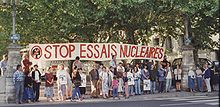
Demonstration against nuclear testing in Lyon, France, in the 1980s.
See also: Nuclear weapons debate and History of the anti-nuclear movement
Even before the first nuclear weapons had been developed, scientists involved with the Manhattan Project were divided over the use of the weapon. The role of the two atomic bombings of the country in Japan's surrender and the U.S.'s ethical justification for them has been the subject of scholarly and popular debate for decades. The question of whether nations should have nuclear weapons, or test them, has been continually and nearly universally controversial.Radioactive fallout from nuclear weapons testing was first drawn to public attention in 1954 when the Castle Bravo hydrogen bomb test at the Pacific Proving Grounds contaminated the crew and catch of the Japanese fishing boat Lucky Dragon.[21] One of the fishermen died in Japan seven months later, and the fear of contaminated tuna led to a temporary boycotting of the popular staple in Japan. The incident caused widespread concern around the world, especially regarding the effects of nuclear fallout and atmospheric nuclear testing, and "provided a decisive impetus for the emergence of the anti-nuclear weapons movement in many countries".[21]
Peace movements emerged in Japan and in 1954 they converged to form a unified "Japanese Council Against Atomic and Hydrogen Bombs". Japanese opposition to nuclear weapons tests in the Pacific Ocean was widespread, and "an estimated 35 million signatures were collected on petitions calling for bans on nuclear weapons".[22]
In the United Kingdom, the first Aldermaston March organised by the Campaign for Nuclear Disarmament took place at Easter 1958, when several thousand people marched for four days from Trafalgar Square, London, to the Atomic Weapons Research Establishment close to Aldermaston in Berkshire, England, to demonstrate their opposition to nuclear weapons.[23][24] The Aldermaston marches continued into the late 1960s when tens of thousands of people took part in the four-day marches.[22]
In 1959, a letter in the Bulletin of Atomic Scientists was the start of a successful campaign to stop the Atomic Energy Commission dumping radioactive waste in the sea 19 kilometres from Boston.[25] In 1962, Linus Pauling won the Nobel Peace Prize for his work to stop the atmospheric testing of nuclear weapons, and the "Ban the Bomb" movement spread.[26]
In 1963, many countries ratified the Partial Test Ban Treaty prohibiting atmospheric nuclear testing. Radioactive fallout became less of an issue and the anti-nuclear weapons movement went into decline for some years.[21][27] A resurgence of interest occurred amid European and American fears of nuclear war in the 1980s.[28]
Non-weapons uses
Main article: Peaceful nuclear explosions
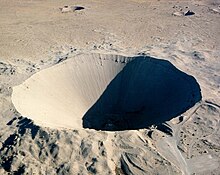
The 1962 Sedan nuclear test formed a crater 100 m (330 ft) deep with a diameter of about 390 m (1,300 ft), as a means of investigating the possibilities of using peaceful nuclear explosions for large-scale earth moving.
Synthetic elements, such as einsteinium and fermium, created by neutron bombardment of uranium and plutonium during thermonuclear explosions, were discovered in the aftermath of the first thermonuclear bomb test. In 2008 the worldwide presence of new isotopes from atmospheric testing beginning in the 1950s was developed into a reliable way of detecting art forgeries, as all paintings created after that period may contain traces of cesium-137 and strontium-90, isotopes that did not exist in nature before 1945.[30]
Nuclear explosives have also been seriously studied as potential propulsion mechanisms for space travel (see Project Orion).
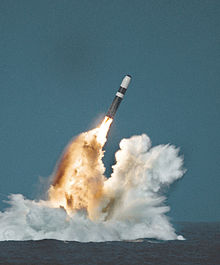
No comments:
Post a Comment